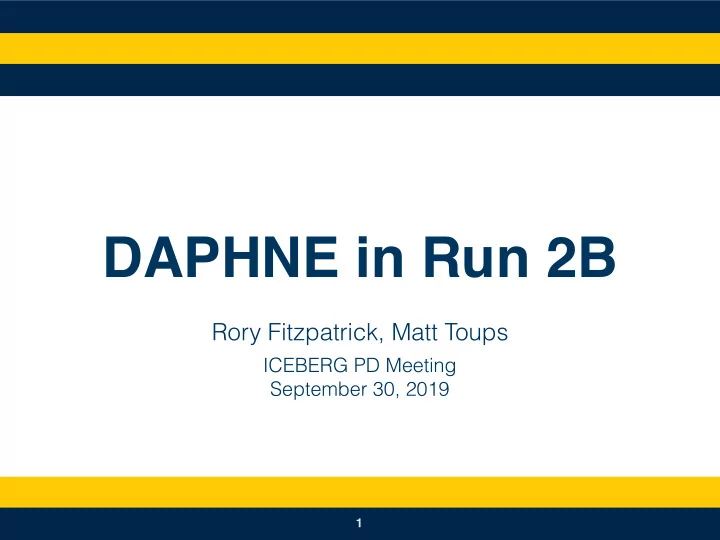

DAPHNE in Run 2B Rory Fitzpatrick, Matt Toups ICEBERG PD Meeting September 30, 2019 � 1
DAPHNE • Big thanks to everyone who has been trained to take data with DAPHNE and to those remote who have volunteered to look at data! • The DAPHNE run log can be found here. • DAQ instructions for DAPHNE can be found here. - In-person training is required to operate the PD system. � 2
first cold tests • In the initial tests of the PD system, we saw no signals coming from the s-arapuca. s-arapuca x-arapuca • This was traced to a finicky connection at the flange and has been resolved. • Should be kept in mind during future runs. 1 tick = 12.55 ns � 3
cosmic paddle placement • We still regularly see events where the s-arapuca signal is suppressed. • It appears as though the bottom cosmic paddle is slightly shifted away from the desired position and we’re likely still getting tracks that pass behind the s-arapuca. cosmic x-arapuca s-arapuca paddles x-arapuca s-arapuca 1 tick = 12.55 ns � 4
wednesday 9/25 - friday 9/27 • There was cryogenic work happening during the end of last week, but we did acquire several hours of data using only the top cosmic paddle as a trigger. - Scanned a range of warm electronics gains. We think we have enough data to demonstrate that DAPHNE is operating at an appropriate gain setting (thanks to Matt for doing this!) • On Friday: took data immediately prior to the very first SSP run (more from Bishu next) so we can compare waveforms and noise levels between the two systems. • The internal filter system was turned on Friday afternoon and it was requested that we leave the PD off over the weekend. � 5
noise average FFT s-arapuca more low frequency noise observed than normal, but there was a lot of activity around the cryostat and it still wasn’t completely full. � 6
noise II • The low frequency noise is correlated between channels. x-arapuca s-arapuca • By subtracting one channel di ff erence from another, we can better isolate warm electronics noise. • Still in the process of studying this data, but first impressions suggest we’re operating at an appropriate gain setting. � 7
summary • Getting more people involved with DAPHNE data analysis and data taking. • Preliminary data taken last week may be sufficient to demonstrate DAPHNE is operating at an appropriate gain setting. • We have additional data scanning sipm voltage in 1 V steps. • Looking forward to comparing our noise levels and waveforms to SSP data. � 8
Recommend
More recommend